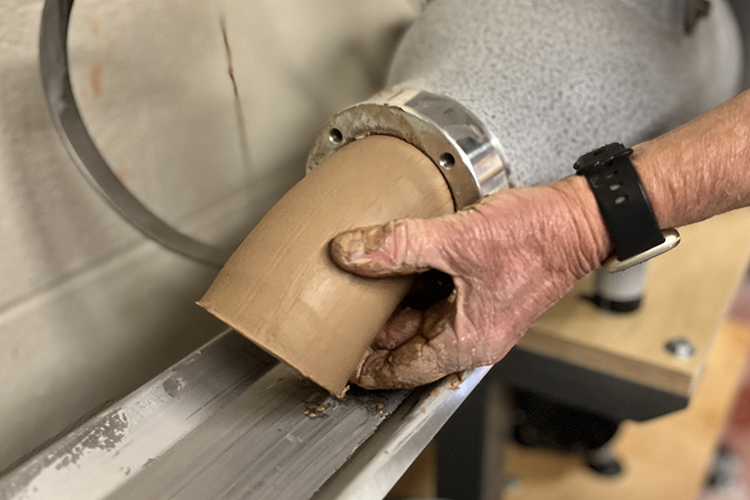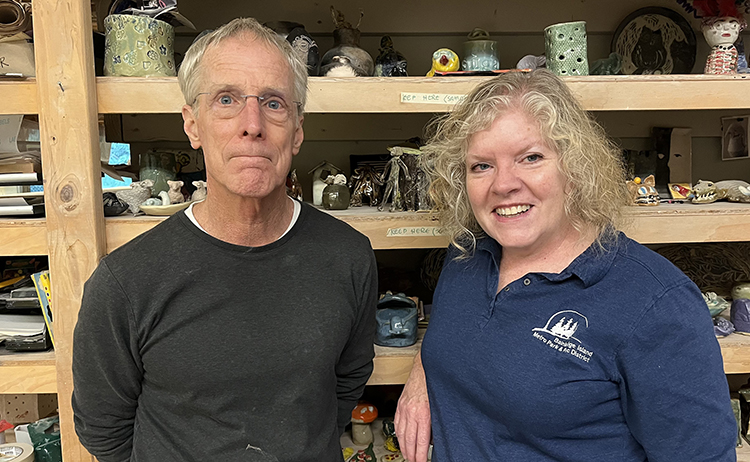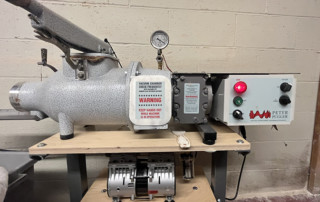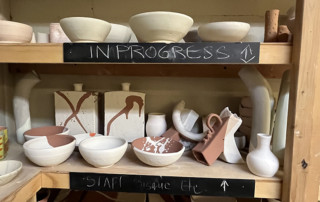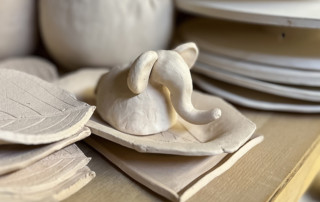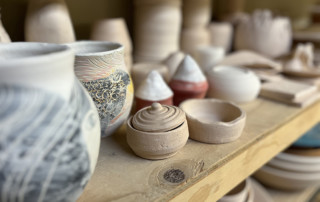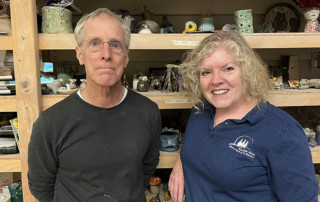Humans have been using clay for some time now – 16,000 years at last count, give or take an epoch – to craft everything from water jugs to funerary vessels, bricks to busts, tablets to trinkets.
Malleable when wet but reliably ridgid when fired or dried, it’s no stretch to think of clay as a wonder material upon which a good chunk of civilization itself has been built.
Turns out clay was way out in front of the recycling curve, too. Here, a dash of modernity helps.
“What’s neat about clay is that none of it has to be wasted, and you can keep using it over and over,” says Debbie Fecher-Gramstad, sculpture instructor at Eagledale Pottery Studio. “But the process of making used clay usable again, that has been hard and slow.”
Until now. “Peter Pugger,” the studio’s new pug mill – essentially a recycling machine for potters’ scraps – is churning out reconstituted clay for the studio at an unprecedented pace. Waste not … you know the rest.
“Clay prices continue to rise, like everything else,” said Shannon Buxton, studio director. “If we can do a better job of recycling what our students are using, that benefits them in the long run because it keeps their classes affordable.”
The pug mill was funded by a $1,450 Community Grant from the Bainbridge Island Parks & Trails Foundation. It was one of six Community Grants totaling $18,000 in the Foundation’s fall 2021 cycle. Other grants went to Bainbridge Island Water Polo, BHS Sailing, BI Swim Club, Boy Scouts Troop 1564, and the Park District’s Park Stewards program.
Meet Peter Pugger
About “pug,” the word: you can use it as a verb (“to mix clay into a soft, workable consistency”) or noun (clay that has been so prepared). Thus, “pugging” is both the machine’s process and function, and “pug” clay is its product.
So you’re at the Eagledale Pottery Studio, throwing a functional pot on a wheel, say, or making a little elephant figurine just because. As you go, you find you need to trim down the pot’s base so it sits nicely, or snip an inch or two off the elephant’s trunk for scale.
Multiply these tiny decisions by a whole studio – some 300 members strong in a given quarter – over a week of serious potting and sculpting, and that’s a lot of leftover clay. Where does it all go?
Heretofore, scrap clay has piled up outside in bins, kept moist until it could be run through a tired, low-output mill that was no match for the volume the studio produced. The machine’s exposed auger turned ceaselessly, a hazard for users’ fingers. Volunteers weren’t allowed anywhere near it.
“The old one had great limitations in capacity and safety even, it was such an old piece of equipment,” Buxton said. “It was so frustrating. So the answer was to get something that you can load with clay and hit a button and walk away from, and not something you had to monitor or stick your hand into.”
Enter Peter Pugger. (For the record, it’s a trade name.)
Briefly: Scrap clay is packed en motte into the mill’s chamber and compressed with a levered, sealed door. Flip the switch and an auger turns, mixing and kneading the clay while a vacuum pump draws out air pockets and bubbles.
And presto: out the end comes a long, log-like extrusion of “shop clay,” an amalgam of whatever varieties went into the hopper. Sections about the size of soup cans are cut off one by one, and packed away for reuse by studio artists.
So your beautiful pot cracks, or your first try at an elephant looks more like a blob? No worries – even dried clay can be reconstituted in the mill. Just add water.
The studio keeps many clay varieties on hand, each colorfully named, each with its own character, texture or hue: Oregon Brown, Whitestone, Idaho Buff, Naranja, Little John, Dakota Red, Dakota White, Mac 10, Rod’s Bod, Death Valley Red. Plus porcelain, which studio employee Andy Hicks describes as “like throwing cream cheese.” All are grist for the pug mill.
Pottery students can pay for their choice of clay type, but the pug mill’s reconstituted “shop clay” is provided free for studio toe-dippers, visiting kids’ workshops and Friday night “Clay Play” events.
“We have people who have been here for decades – it’s their hobby, their joy and their socialization,” Buxton said. “Folks that are maybe only here for one or two visits may feel badly when they have a whole bunch of clay left over, and they’re like, ‘Do you throw this away? It’s perfectly good.’
“Now we have a way to recycle it well.”
The pug mill in action
The recycling process from scrap clay to reconstituted “shop clay” via the Eagledale Pottery Studio’s new “pug mill,” funded by a grant from the Bainbridge Island Parks & Trails Foundation. Recycled clay goes right back to use by pottery students and studio visitors for their array of creations.



